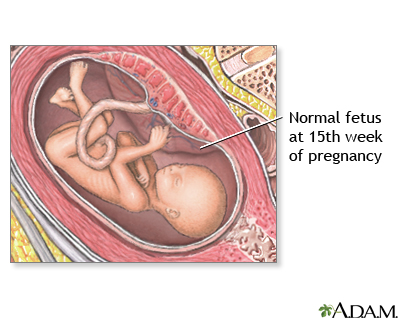Welcome To Week 15
Your Baby: The Start Of Thumb Sucking
At this stage, your fetus weighs approximately 1.75 ounces (50 g) and measures just over 4 inches (10.2 cm). Hair is sprouting everywhere. The fetus gets fine hair all over (called lanugo) to protect it from the constant exposure to the amniotic fluid. Skin formation is progressing, but is very thin (you can even see small blood vessels forming underneath). At this point, the baby might even be sucking its thumb!
Your Body: The ABCs Of AFP
- What is an AFP? The AFP is a blood test that measures the levels of alpha-fetoprotein in the mother's blood or serum. Also called maternal serum alpha-fetoprotein (MSAFP), this test is part of the quadruple screen that measures the fetus-produced substance, as well as three others that are present in pregnant women -- human chorionic gonadotropin (h CG), a hormone produced in the placenta; inhibin A, another hormone, and unconjugated estriol, an estrogen produced by both the fetus and the placenta.
- When is the test taken? To get the most accurate results of the triple screen, the test should be done between 15 and 18 weeks after the first day of your last menstrual period.
- What is the purpose of the test? The quadruple screen is performed to assess whether your fetus is at a greater risk for having chromosomal defect such as Down syndrome or a greater risk of having a a neural tube defect. Abnormal levels of AFP, both high and low, may indicate some sort of birth defect. A level that is high may indicate a neural tube defect (such as spina bifida), and a low level could indicate Down syndrome.
- How safe is it? The blood test is like any other maternal blood test and poses no harm to the mother or the fetus. The real risk is that a false-positive result may require further testing -- such as amniocentesis -- a more invasive procedure.
- How reliable are the results? The quadruple test is a screening tool used to identify women at increased risk for fetal problems. Therefore, it is a very sensitive test. Importantly, a positive result doesn’t mean you baby is abnormal – it just means that your baby’s risk of Down syndrome is greater than 1 in 270, or more than 0.4 percent. When you get your result, your health care provider should tell you your estimated risk of Down syndrome. If it’s 1 in 200, there’s a 99.5 percent chance you baby is normal. Even if it’s 1 in 10, there’s a 90 percent chance your baby is normal. The only way to know for sure if your baby is affected is to have an amniocentesis, a procedure that collects fluid from around the baby and checks for chromosome problems.
Sometimes, an abnormal result has nothing to do with a chromosome problem. Instead, it can be attributed to an incorrect estimation of the age of the fetus; twins (both babies produce the substance); or not taking into account your weight, race, or the presence of diabetes. Be sure to review your results with your health care provider.
On a Different Note: Seeing For Yourself
Depending on your circumstances -- and on your health insurance -- you might not get to see your little one on an ultrasound until midway through your pregnancy (around week 18 to 20), when you will have a detailed ultrasound of your baby to check all of the anatomy.
Weekly Tip
Take the Alpha-fetoprotein (AFP) test on the early side of the window in case you get a false-positive or false-negative result, and there is need for further testing. That way, you'll have plenty of time to get genetic counseling, do a more in-depth ultrasound, and get an amniocentesis, if you choose to do so. Click here to learn more about the AFP
Review Date: 2/6/2007
Reviewed By: Douglas A. Levine, MD, Gynecology Service, Memorial Sloan-Kettering Cancer Center, New York, NY. Review provided by VeriMed Healthcare Network.
The information provided should not be used during any medical emergency or for the diagnosis or treatment of any medical condition. A licensed physician should be consulted for diagnosis and treatment of any and all medical conditions. Call 911 for all medical emergencies. Adam makes no representation or warranty regarding the accuracy, reliability, completeness, currentness, or timeliness of the content, text or graphics. Links to other sites are provided for information only -- they do not constitute endorsements of those other sites. Copyright
A.D.A.M., Inc. Any duplication or distribution of the information contained herein is strictly prohibited.




